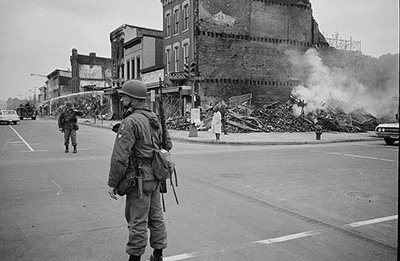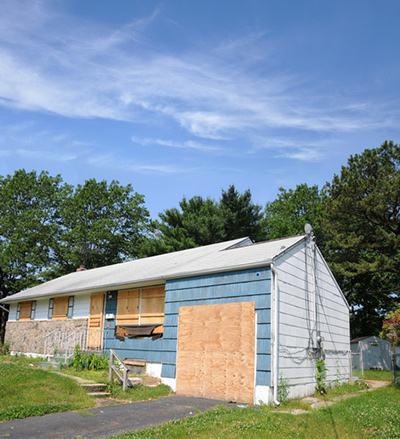In the early to mid-20th century, American cities were the engines of opportunity and mobility in the industrial United States. Economic growth was synonymous with city growth. By contrast, the second half of the 20th century witnessed the precipitous decline of the industrial city, the rise of the sprawling suburban metropolis, and the racial and economic fracturing of metropolitan regions around the country. The processes of deindustrialization and suburbanization have reinforced the socioeconomic distance between the haves and the have-nots. Opportunity is hugely uneven within and across metropolitan areas and old-line cities still struggle with deeply entrenched poverty.
Despite this reality, we have seen some formerly declining cities do better in the last few decades. New York and Chicago are increasingly desirable places to live and cities like Pittsburgh and Philadelphia are seeing their populations and property values stabilize after a long period of relative decline. This nascent urban resurgence should remind us that cities have always been engines of economic creativity, ingenuity, and opportunity. Cities are huge generators of wealth. But for cities to do what they do best—turn working-class people into middle-class people—the resources that are generated by cities have to be plowed back into the kinds of public goods that benefit everyone, not just a narrow slice of the already favored. At midcentury, cities provided the basic services like schools, housing, transportation, health care, parks, and playgrounds that gave working-class people the resources to move into the middle class. President Franklin Roosevelt famously partnered with New York’s Mayor Fiorello LaGuardia to provide funding for these projects. Cities can provide those goods again. The next president can help them do so.
The way to empower cities is not to adopt a raft of new urban economic development policies. The last 75 years of urban policy have mostly been a failure. Instead of an urban policy, the next president should adopt a city power policy. To do so requires the new administration to take four steps:
The failures of urban policy
The first step is to acknowledge the failures of federal urban policy. After the riots of the 1960s, the Kerner Commission sought to promote an “urban Marshall Plan”—large, sustained federal investments in inner-city neighborhoods. That plan never materialized. Richard Nixon’s election in 1968 and the general abandonment of the War on Poverty brought an end to inner-city efforts. Instead, federal funds were and continue to be directed toward highway building, urban renewal, and other forms of urban economic development. These funds benefit developers, downtown business interests, the construction trades, and other interest groups without demonstrably improving the condition of depressed urban neighborhoods, and oftentimes make the residents of those neighborhoods markedly worse off. Ethnic and racial minorities were particularly hard hit. For African Americans in the mid-20th century, urban renewal was known derisively and bitterly as “Negro removal.” Across the country federal funds were used to displace poor blacks, tear down their neighborhoods, and replace small businesses with larger ones.

After the riots of the 1960s, the Kerner Commission sought large, sustained federal investments to inner-city neighborhoods but those funds never materialized.
These federal expenditures did not prevent urban decline in large part because the underlying theory was mistaken. Urban economic policies have consistently failed because they have sought to shift people around the metropolitan area. The basic idea has been to encourage middle-class suburbanites to return to the central city or to encourage poor inner-city residents to move to the suburbs. Cities have been repeatedly told that to become economically viable they must attract and retain the “creative class,” the middle class, or the luxury class. Urban renewal was itself a massive effort to remake the city by replacing one set of residents with another. It didn’t work. And it continues to fail.
Instead of thinking about the city as a product that needs to attract low-cost, high-tax-paying residents, we should think about cities as engines of economic opportunity in their own right. Giving existing working-class residents the tools to become middle class in place should be the goal of the next administration—not moving residents hither and thither in an attempt to cobble together a sustainable tax base. Instead of treating cities as passive jurisdictions “competing” for resident-users of public services, we should understand them as engines of economic development and upward mobility.
American cities played and continue to play a significant role in creating an urban middle class, both by creating wealth and by providing public goods. Consider that in a 40-year span in the middle of the 20th century, New York City built thousands of units of working- and middle-class housing; hundreds of schools, libraries, and parks; and thousands of miles of roadways, bridges, tunnels, and subways. The Roosevelt-LaGuardia partnership was essential to these developments and the basic infrastructure built by the newly emergent industrial cities raised living standards for the rural and urban poor alike. Those goods helped produce a robust urban middle class at midcentury. In many places these urban goods continue to provide the working class, the poor, and newly arrived immigrants resources for upward mobility. Those resources are basic and obvious: security, education, transportation, health, and shelter. The new president should think of cities as agents of economic mobility. Instead of dictating policy from above, the administration should work with cities to generate economic growth from below.
Stop the subsidy race

The partnership between President Franklin Roosevelt and Mayor Fiorello LaGuardia of New York provided funding to build housing, schools, libraries, roads, and parks.
A second problem distracts cities from the effective provision of basic goods: the intermunicipal competition for industry and business. Urban redevelopment policy has been focused on creating jobs by inducing business relocation, but here again, the influx of federal dollars mostly upends communities instead of supporting them. In a regional or national employment market, bringing more jobs into a city does not mean that those jobs will be filled by local residents or that more jobs will reduce poverty among the existing needy. New jobs are just as easily filled by better-educated in-migrants. An influx of industry could also increase local unemployment, as more job seekers migrate into the jurisdiction.
The interlocal competition for jobs is a result of a federal system that encourages competition for tax base. States compete for industry. Cities compete for regionally valuable investments. Providing location subsidies to large employers has been and continues to be a standard tool of city economic development offices. According to some estimates, each year, state and local governments spend close to $80 billion, or roughly 7 percent of their total budgets, on tax incentives, breaks, and outright cash payments to attract corporate investment and relocation.
These subsidies are mostly wasteful, however. There is strong evidence that subsidies do not ultimately alter business location decisions and that cities do not get back what they put in, either in the short or long term. The stories of failure are commonplace. Reporting that five years after locating there, IBM fired most of its employees in Dubuque and Columbia, Iowa, despite a combined $84 million in tax breaks, the author of a Bloomberg News story noted that this scenario “has played out often across America: Big company comes to town, provides boost to the local economy and then leaves.” It is reported that the subsidies provided by Michigan cities to the automobile industry over the years could have easily wiped out all of Detroit’s debt.

Although IBM received tax breaks to open branches in Iowa, it fired most of its employees after only five years.
Smokestack chasing is difficult for state and local government officials to resist. “Shoot anything that flies; claim anything that falls” captures the attitude of state and local politicians and development practitioners. City officials feel the need to do something—anything—to prove that they are pursuing economic growth.
The fracturing of metropolitan regions into hundreds of independent, local jurisdictions does not help. Most metropolitan areas are unified economic regions, but each local government is encouraged to pursue tax base–enhancing policies, regardless of the effects on neighboring jurisdictions. Local governments compete with each other for retail developments, office parks, and other tax-generating commercial projects. At the same time, local governments want to avoid regionally necessary but disfavored uses and anything that generates costs but not tax revenue. Thus, local governments avoid providing low-income or multifamily housing. The result has been an affordable housing crisis—especially on the coasts. In addition, because of the lack of low-income housing in the suburbs, low-income workers in the city face a “spatial mismatch”: they often live far from the jobs that are increasingly located in the far-flung suburbs.
Federal help could solve these regional collective action problems. First, the new president could encourage Congress to stop the interstate subsidy race by proposing legislation that bars state and local tax incentives and subsidies that “poach” productive enterprises from other jurisdictions. Second, the new administration could reduce the incentives for local governments to engage in fiscal races to the bottom by directly providing more education and other social welfare dollars. The national provision of monies for basic social services would help mute interlocal tax competition.
Emphasize basic fiscal stability
Reducing interlocal competition will allow cities to redirect their efforts toward providing basic public goods. The federal government can further encourage these efforts by helping to stabilize local government finances, and the new president can adopt this as a first-year policy goal. Cities’ revenue-raising capacity fluctuates with the booms and busts of the larger economy. American cities in the latter half of the 20th century have lurched from fiscal crisis to fiscal crisis. Cities cannot print money and state constitutions usually prevent them from running deficits. In lean times, this means that cities have to cut back on their spending, often when economic theory would counsel doing the opposite. The result is that local fiscal policy exacerbates economic downturns while cutting services to the most vulnerable.
What can the next president do to give cities the ability to provide quality local services even in economic downturns? One answer is revenue sharing. In 1972, Richard Nixon ushered in an era of federal-state-local revenue sharing that lasted until 1986. Nixon’s program transferred much-needed funds from federal coffers to state and local governments, helping to stabilize local budgets. The money came with few strings—local governments were empowered to decide for themselves how to use the funds. The program was popular. Democrats welcomed much-needed aid for struggling cities. Republicans saw revenue sharing as a way of devolving political authority to local communities.

The foreclosure and eviction crisis that followed the 2008 recession continues to cause a great deal of financial stress for cities.
The new administration can help to stabilize local finances in other ways too. Consider federal housing and transportation policies. Since the Great Depression, the federal government has encouraged home ownership by underwriting the home mortgage system. Securitization and deregulation of the mortgage industry, however, ultimately led to overlending and economic collapse. The foreclosure and eviction crisis that followed the 2008 recession continues to cause a great deal of local fiscal stress. Cities cannot stabilize their populations or tax base when they are glutted with foreclosed homes. The federal government needs to regulate the mortgage industry, but also to adopt programs that keep people in their homes. Preventing predatory lending practices before they occur is essential.
The uncertainty of federal transportation budgeting also exacerbates urban difficulties. For cities needing to repair and replace aging infrastructure, there is often either too much money or not enough. Large-scale highway projects absorb too much money. Meanwhile basic maintenance on existing roads is neglected and alternatives to automobile-based transportation are often ignored. Again, stabilizing local finances and helping cities provide basic services should be a first-year priority for the next president.
Get out of the way
Once state and federal governments create a stable fiscal environment, they should get out of the way. Cities are capable of promoting economic opportunity and mobility if we just let them.
Consider the number of cities that have now adopted living wage legislation—a policy that has been shown to reduce poverty significantly. Cities are also adopting family leave, health care, and labor-friendly legislation—addressing inequality in the absence of state or federal regulation.
Economic theorists often assert that the minimum wage and other forms of social welfare regulation have to be pursued at the national level. Conventional wisdom suggests that municipal regulation will prompt businesses and residents to flee.
But that is not what has happened. Millions of Americans are now living in cities with minimum wages that will reach at least $15 an hour. The efforts by mayors and city councils in Los Angeles, New York, Chicago, Santa Fe, and hundreds of other cities have also induced some states to adopt higher minimums. Cities have been the first movers in regulating low-income service work and in providing much-needed support for low-income laborers.
Indeed, the primary barrier to cities addressing economic inequality is state and federal interference. State legislatures regularly adopt preemptive legislation that prevents cities from acting. Federal law also makes it difficult, if not impossible, for cities to adopt regulations that directly regulate labor rights or mortgage lending. Cities need more room to maneuver. The new administration can give them this policy space by avoiding unfunded mandates, by directing federal agencies to permit local flexibility in applying social welfare programs, and by providing resources directly to cities, bypassing state legislatures. Preemptive federal laws should be modified to permit cities more room to regulate in areas like labor and employment, banking, and insurance.
When cities have the authority, they can do a great deal. In analyzing local social welfare policy, urban theorist Michael Craw found that even when constrained by limited fiscal capacity, many local governments “still have a significant degree of independence in reacting to local policy preferences when it comes to decisions on providing social welfare services and participating in federal and state intergovernmental grants.” He concludes that rather than “simply being ‘junior partners’ to federal and state governments, some local governments possess considerable autonomy in addressing local poverty.” Political scientists Chris Tausanovitch and Christopher Warshaw recently found that “liberal” cities have higher taxes, less regressive tax systems, and spend over twice as much per capita than do “conservative” cities on social welfare.
Despite conventional economic theory, cities are addressing inequality, and doing so aggressively. City residents are willing and able to pay taxes for redistributive social programs. And the wealth being generated in cities is being plowed back into city services.
City power
A city power policy should encourage these trends. The benefit of a federal political system is that it permits local jurisdictions to pursue ends that are responsive to local constituencies. For a long time, federal urban policy treated cities as needy dependents—as problems to be solved or ignored. Urban policy often overlooked the ample resources already existing in urban neighborhoods or took advantage of those resources to enrich real estate or downtown business interests. The new administration should reject past failed developmental policies, stop the interlocal subsidy race, give cities a modicum of basic fiscal stability, and then get out of the way. Cities can be instruments for advancing economic opportunity and mobility. The next president should recognize and respect that fact.